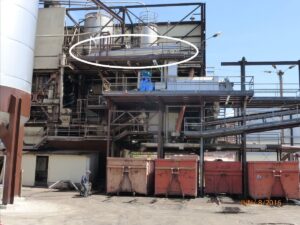June 25, 2020
Two coffee processors called us this year because their coffee grounds presses started making wet press cake. In both cases it turned out too much water was getting into the flow going into the press. At one plant, a steam valve to the blow-down tank ahead of the press had jammed open. In another, draining screens in the silos over the press had blinded over, needing pressure washing. Once these problems were fixed, the presses resumed making press cake with nicely under 60% moisture content. We learned that Vincent presses do not work with too much water in the grounds.
For background, factories for producing instant coffee are found in over forty countries of the world, but only three or four companies in the United States have plants. This is because only 10% of the coffee consumed in the US is made from instant coffee. In contrast, in most foreign countries 90% is from soluble coffee. Nestlé’s Nescafe is the name known worldwide.
At harvesting, coffee beans have the exterior pulp layer removed, followed by drying and bagging. Obviously, there are many varieties and grades. These beans are exported as the raw material for the instant coffee factories.
Production of instant coffee starts with cleaning, roasting, and flaking (grinding). Probat coffee roasters are extremely well known. They are manufactured in both Germany and Brazil.
Once prepared this way the beans are loaded into pressure vessels. The vessels are arranged for counterflow washing of the coffee. This process produces a flow with all of the coffee solubles being pumped to either a spray dryer or freeze drying. Spray drying consists of a tower many stories tall, with a spray head at the top. At the bottom of this tower the powdered coffee is collected for packaging.
GEA Process Engineering, headquartered in Stockholm, is the leader in this process of producing instant coffee. Their pressure vessel system as well spray dryers and freeze dryers are recognized throughout the industry.
Vincent’s role in the industry is in dewatering the spent coffee grounds. After extraction, the coffee is a wet, tasteless mass, but with a high BTU content. A screw press will reduce the moisture content of the coffee to the range of 50% to just under 60% moisture. In this moisture range the spent coffee is burned in grate or fluidized bed boilers. The steam is used in the plants for extraction, evaporation, heat exchangers, and drying. Some plants are energy self-sufficient, with all of their energy needs for steam coming from burning their coffee grounds.
An alternative boiler design used for burning spent coffee is common in Colombia. They take the press cake from our screw presses and dry it down to 10% moisture content in a rotary drum dryer. This material can be burned in a conventional boiler, without the cost and complexity of a fluidized bed unit. It is the boiler chimney gasses which are used to dry the press cake down to 10% moisture content. At this low moisture, the cake burns in suspension, like pulverized coal or natural gas.
Vincent’s long history in this industry is traced by the following Pressing News newsletters:
| #056 | February 1997 | COFFEE |
| #149 | May 2004 | COFFEE PULP |
| #153 | October 2004 | SPENT COFFEE |
| #241 | January 2012 | BIOMASS BURNING SYSTEM (Good one!) |
| #285 | July 2016 | FILTERING SPENT COFFEE PRESS LIQUOR |
| #308 | July 2018 | COLD BREWED COFFEE |
USERS’ LIST: https://vincentcorp.com/content/spent-coffee-tea
The photo below shows where draining screens (circled) were added to the screw conveyor which carries coffee grounds to a VP-24 press.

#325
